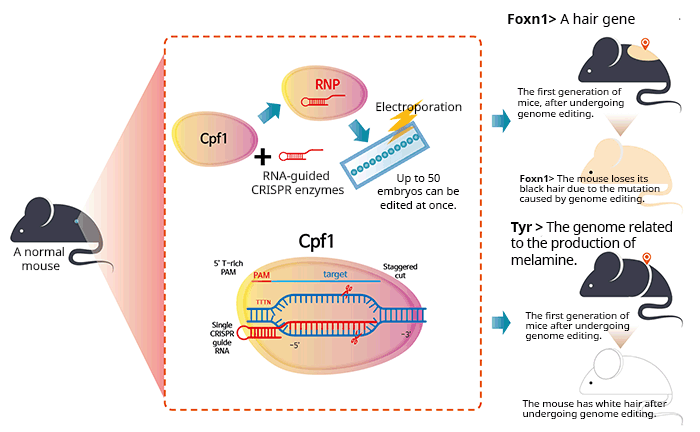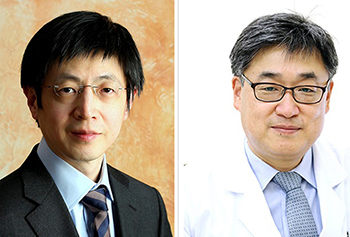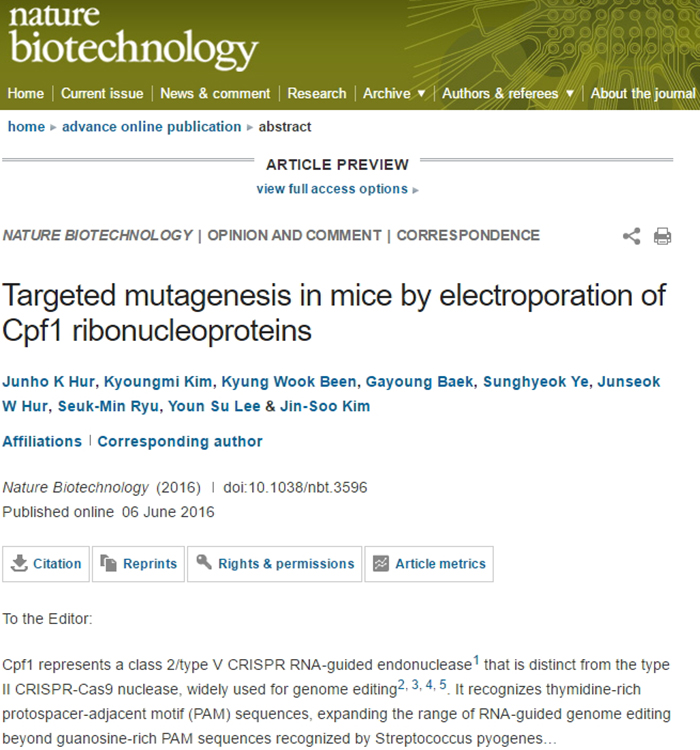Korean researchers have developed a new “DNA scissors" technology that can accurately cut out one sole strand of double-stranded DNA.
Teams of researchers -- a research team from the Institute for Basic Science (IBS), led by the Center for Genome Editing's Director Kim Jin-Soo, and another team led by Professor Lee Sang-Wook of University of Ulsan College of Medicine -- successfully edited genomes of a mouse embryo by using this newly developed "DNA scissors" technology, called CRISPR Cpf1.
“DNA scissors” are designed for genome editing by cutting a specific part of the DNA, to make alterations by using an artificial nuclease for DNA cutting. This technology is designed to remove abnormal genes that cause certain diseases and replace them with healthy genes, allowing scientists to correct abnormal genes in humans, animals and even plants.
Existing "DNA scissors" technology that uses nuclease Cas9 has many side effects, including low accuracy and mutations, as it cuts both strands of DNA.

Using the new technology, researchers were able to cut out the genes that produce melanin from the fertilized egg of a black mouse. The mouse that was eventually born had white dots on its abdomen. In later generations, it will have descendants that are completely white. The researchers also developed their own “digenome-sequencing method” to investigate the order of the removed genes. This raises accuracy rates by measuring the possibility of mistakes or malfunctions.

Director Kim said, “The existing 'DNA scissors' technology using nuclease Cas9 didn't cut only the selected genes, but also more than 90 other genes, if applied to human genes. Our new technology uses nuclease Cpfl and can cut only the sole, chosen gene much more accurately.”
“If we use the new Cpfl-based 'DNA scissors' technology, it can be more widely used for genome editing, not only in humans but also in animals such as mice, cows or pigs,” Kim added.
The research and results were introduced by the international biotech publication Nature Biotechnology on June 7.
By Yoon Sojung
Korea.net Staff Writer
Photos: IBS, Ulsan University Hospital
arete@korea.kr

Teams of researchers -- a research team from the Institute for Basic Science (IBS), led by the Center for Genome Editing's Director Kim Jin-Soo, and another team led by Professor Lee Sang-Wook of University of Ulsan College of Medicine -- successfully edited genomes of a mouse embryo by using this newly developed "DNA scissors" technology, called CRISPR Cpf1.
“DNA scissors” are designed for genome editing by cutting a specific part of the DNA, to make alterations by using an artificial nuclease for DNA cutting. This technology is designed to remove abnormal genes that cause certain diseases and replace them with healthy genes, allowing scientists to correct abnormal genes in humans, animals and even plants.
Existing "DNA scissors" technology that uses nuclease Cas9 has many side effects, including low accuracy and mutations, as it cuts both strands of DNA.

Researchers successfully altered the genomes of a fertilized egg of a black mouse using the newly developed 'DNA scissors' technology that uses the new nuclease Cpfl. They removed the genes that create black hair and eventually a black mouse with white dots was born. The new technology was covered in the press as it achieved its results without causing any side effects on the mice.
Using the new technology, researchers were able to cut out the genes that produce melanin from the fertilized egg of a black mouse. The mouse that was eventually born had white dots on its abdomen. In later generations, it will have descendants that are completely white. The researchers also developed their own “digenome-sequencing method” to investigate the order of the removed genes. This raises accuracy rates by measuring the possibility of mistakes or malfunctions.

Research into the newly developed 'DNA scissors' technology is led by the Center for Genome Editing's Director Kim Jin-Soo (left) and Professor Lee Sang-Wook of University of Ulsan College of Medicine.
Director Kim said, “The existing 'DNA scissors' technology using nuclease Cas9 didn't cut only the selected genes, but also more than 90 other genes, if applied to human genes. Our new technology uses nuclease Cpfl and can cut only the sole, chosen gene much more accurately.”
“If we use the new Cpfl-based 'DNA scissors' technology, it can be more widely used for genome editing, not only in humans but also in animals such as mice, cows or pigs,” Kim added.
The research and results were introduced by the international biotech publication Nature Biotechnology on June 7.
By Yoon Sojung
Korea.net Staff Writer
Photos: IBS, Ulsan University Hospital
arete@korea.kr

Nature Biotechnology publishes an article about the new 'DNA scissors' technology on June 7.